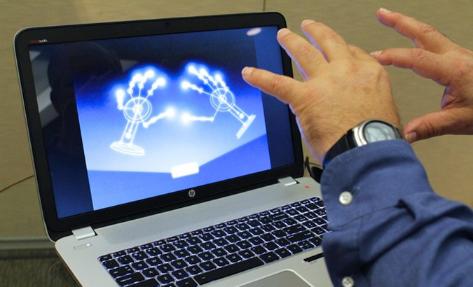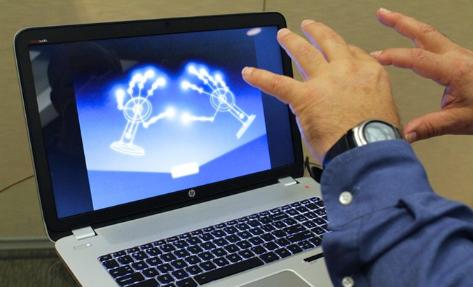Leap Motion, HP ENVY and the Future of Augmented Reality - Shelly Palmer

This fall, HP will ship a laptop, the ENVY17, which will be the first laptop to ship with Leap Motion technology embedded into the hardware. Not only that, but the Leap Motion sensor included in the laptop is dramatically smaller than previous embedded designs.
 HP ENVY17 with Leap Motion technology
HP ENVY17 with Leap Motion technology
If you're unfamiliar with Leap Motion, prepare to have your mind blown. You know that bit in The Avengers where Tony Stark spreads his fingers apart in mid-air and the stuff on the screen in front of him instantly appears on displays throughout the room? That's what Leap Motion is. It's built around advanced motion sensing technology for human–computer interaction, and engineered to make 3D modeling as easy in the digital realm as it is in real life.
The original Leap Motion controller was a small, $80 USB device that you'd place on your desk, facing up. The controller would use two cameras and three LEDs to track your fingers (or similar items, like a pen). Its most direct comparison to a more widely-used technology would be Microsoft's Kinect, but instead of tracking your whole body's movements, it would only track an area about three feet across, in front of your laptop.
The tech embedded in the ENVY17 is about 70 percent thinner than the existing components in the Leap Motion without any loss in performance, according to Leap Motion CEO and co-founder Michael Buckwald said in an interview. The sensor is embedded right next to the laptop's mouse trackpad, and is thin enough to be embedded in just about any laptop available on the market. Leap Motion wants to be in as many devices as possible; HP's ENVY17 is just the first of many steps.
Exo-Digitally Enhanced Humans
If Leap Motion's technology finds its way into more laptops in the coming months, it will be the latest in a long line of recent gadgets aimed to benefit exo-digitally enhanced humans – a topic I covered last fall. Here's a refresher:
What is an exo-digitally enhanced human? It is a person with a network-connected smartphone, tablet or other digital tool who knows how to use it. The best users have already outsourced their factoid and informational memory to Google, Wikipedia, IMDB, PubMed and other specialized databases. Short number memory is outsourced to the favorites section of your smart phone software. Way-finding cells in your hippocampus are atrophying because you have outsourced your way-finding to GPS systems and mapping software.
Think about all the new devices and gadgets that have made their way to the forefront of the Connected World in the 11 months since I wrote that article. Leap Motion. Google Glass. Galaxy Gear. I could go on and on, but you get the point: We now have more tools at our disposal to make our lives easier and make ourselves more powerful than ever before.

A possible future of Google Glass and other wearable technology?
Exo-digitally enhanced humans are on the cusp of a whole new area of tech, too. Leap Motion and Glass are heading into a new realm of consumer technology that, up until a year or two ago, has only been seen in science-fiction movies: augmented reality.
Augmented Reality
Augmented reality (or AR) is the natural world we live in, made better; it is augmented by computer-generated inputs like sound, video, or GPS. It's a conversation you have with your friend, where you can still keep eye contact and check the Yankees score. It's a jogging route you've never taken before, with GPS guidance the whole way to keep you from getting lost. It's being able to use your fingers to shape a 3D model on your computer, the same way you would if you were molding clay.
As wearable technology proliferates – from watches to glasses, from shirts to belts – augmented reality will become our main reality. Forget the days when you had to wait to get home to look something up on your computer – you won't even have to check your phone anymore. Everything you'll ever need to know will be available to you, and it will all be overlaid over "real life."
Augmented reality will change the way we do everything. Imagine the doors opened by no longer needing to use your hands to hold your phone or to move your mouse. We'll waste no time getting to the data we want, or doing what we want to do.
Imagine, for a second, going to the grocery store. As it stands now, you walk around the store, hunt for the things you want to buy, put them in your cart, bring them to the front of the store, get rang up by the cashier, who also processes your payment.

Augmented Reality (AR) in a grocery store
Now imagine that same grocery store with an AR overlay, showing you the optimal route to everything on your shopping list. Once you have everything, your Google Glass (or whatever wearable technology is en vogue at the time) has already calculated what's in your cart, given you a subtotal, passed the information along to the supermarket, and charged your debit card.
There is no more tedium in life with AR; everything is automated. You're freed to become more productive and more efficient. You're the best you that you can be. You're an exo-digitally enhanced human.
Shelly Palmer is Fox 5 New York's On-air Tech Expert (WNYW-TV) and the host of Fox Television's monthly show Shelly Palmer Digital Living. He also hosts United Stations Radio Network's, Shelly Palmer Digital Living Daily, a daily syndicated radio report that features insightful commentary and a unique insiders take on the biggest stories in technology, media, and entertainment. He is Managing Director of Advanced Media Ventures Group, LLC an industry-leading advisory and business development firm and a member of the Executive Committee of the National Academy of Television Arts & Sciences (the organization that bestows the coveted Emmy® Awards). Palmer is the author of Television Disrupted: The Transition from Network to Networked TV 2nd Edition (York House Press, 2008) the seminal book about the technological, economic, and sociological forces that are changing everything, Overcoming The Digital Divide: How to use Social Media and Digital Tools to Reinvent Yourself and Your Career; (York House Press, 2011) and Digital Wisdom: Thought Leadership for a Connected World (York House Press, 2013). For more information, visit shellypalmer.com.
Palmer Digital Living Daily, a daily syndicated radio report that features insightful commentary and a unique insiders take on the biggest stories in technology, media, and entertainment. He is Managing Director of Advanced Media Ventures Group, LLC an industry-leading advisory and business development firm and a member of the Executive Committee of the National Academy of Television Arts & Sciences (the organization that bestows the coveted Emmy® Awards). Palmer is the author of Television Disrupted: The Transition from Network to Networked TV 2nd Edition (York House Press, 2008) the seminal book about the technological, economic, and sociological forces that are changing everything, Overcoming The Digital Divide: How to use Social Media and Digital Tools to Reinvent Yourself and Your Career; (York House Press, 2011) and Digital Wisdom: Thought Leadership for a Connected World (York House Press, 2013). For more information, visit shellypalmer.com.
Read all Shelly's MediaBizBloggers commentaries at Shelly Palmer Report.
Check us out on Facebook at MediaBizBloggers.com
Follow our Twitter updates @MediaBizBlogger
The opinions and points of view expressed in this commentary are exclusively the views of the author and do not necessarily represent the views of MediaBizBloggers.com management or associated bloggers. MediaBizBloggers is an open thought leadership platform and readers may share their comments and opinions in response to all commentaries.


